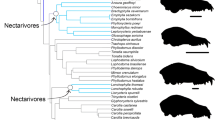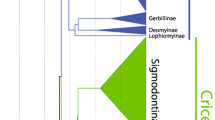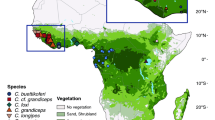Abstract
A positive correlation between diversity and disparity/evolutionary rate is predicted by multiple evolutionary theories. However, recent empirical studies in various taxa do not always find such an association. Similarly, we find no correlation between these two levels of variation, based on cranial morphometric data and molecular phylogenetic data from 317 muroid rodent species and dipodoid outgroups, analyzed using three-dimensional geometric morphometrics. This disassociation was found using both phylogenetic and non-phylogenetic approaches, indicating that an increase in clade richness is not necessarily followed by an increase in morphological divergence and vice versa. Furthermore, the distribution of muroid families in morphospace is highly overlapping suggesting greater variation within than between clades. Taken together with the observation that families with the most distinctive cranial morphologies (nesomyids, dipodids, and spalacids) are the least diverse, indicates that evolution of new cranial morphologies may not play an important role in the diversification of muroid rodents.






Similar content being viewed by others
References
Adams, D. C., Berns, C. M., Kozak, K. H., & Wiens, J. J. (2009). Are rates of species diversification correlated with rates of morphological evolution? Proceedings of the Royal Society B: Biological Sciences, 276(2729), 2738. https://doi.org/10.1098/rspb.2009.0543.
Adams, D. C., & Otárola-Castillo, E. (2013). Geomorph: An R package for the collection and analysis of geometric morphometric shape data. Methods in Ecology and Evolution, 4(4), 393–399. https://doi.org/10.1111/2041-210X.12035.
Akaike, H. (1974). A new look at statistical model identification. IEEE Transactions on Automatic Control, 19, 716–723.
Alhajeri, B. H. (2014). Adaptation, diversification, and desert ecology of the most diverse order of mammals (Mammalia, Rodentia). Tallahassee, FL: Department of Biological Science, Florida State University.
Alhajeri, B. H., Schenk, J. J., & Steppan, S. J. (2016). Ecomorphological diversification following continental colonization in muroid rodents (Rodentia: Muroidea). Biological Journal of the Linnean Society, 117(3), 463–481. https://doi.org/10.1111/bij.12695.
Alhajeri, B. H., & Steppan, S. J. (2018). Ecological and ecomorphological specialization are not associated with diversification rates in muroid rodents (Rodentia: Muroidea). Evolutionary Biology. https://doi.org/10.1007/s11692-018-9449-8.
Álvarez, A., & Perez, S. I. (2013). Two- versus three-dimensional morphometric approaches in macroevolution: Insight from the mandible of caviomorph rodents. Evolutionary Biology, 40(1), 150–157. https://doi.org/10.1007/s11692-012-9194-3.
Blankers, T., Adams, D. C., & Wiens, J. J. (2012). Ecological radiation with limited morphological diversification in salamanders. Journal of Evolutionary Biology, 25(4), 188–203. https://doi.org/10.1111/j.1420-9101.2012.02458.x.
Cardini, A. (2016). Lost in the other half: Improving accuracy in geometric morphometric analyses of one side of bilaterally symmetric structures. Systematic Biology, 65(6), 1096–1106.
Cheverud, J. M. (1995). Morphological integration in the saddle-back tamarin (Saguinus fuscicollis) Cranium. The American Naturalist, 145(1), 63–89.
Cheverud, J. M. (1995). Morphological integration in the saddle-back tamarin (Saguinus fuscicollis) Cranium. The American Naturalist, 145(1), 63–89. Retrieved from http://www.jstor.org/stable/2463147.
Claude, J. (2008). Morphometrics with R. New York: Springer.
Clavel, J. (2014). mvMORPH: Multivariate comparative tools for fitting evolutionary models to morphometric data. R package version 1.0.1. Retrieved from http://cran.r-project.org/web/packages/mvMORPH/index.html.
Fabre, P.-H., Hautier, L., Dimitrov, D., & Douzery, E. (2012). A glimpse on the pattern of rodent diversification: A phylogenetic approach. BMC Evolutionary Biology, 12(1), 1–19. https://doi.org/10.1186/1471-2148-12-88.
Foote, M. (1993). Contributions of individual taxa to overall morphological disparity. Paleobiology, 19(4), 403–419. Retrieved from http://paleobiol.geoscienceworld.org/content/19/4/403.short.
Freckleton, R. P., & Harvey, P. H. (2006). The evolution of morphological diversity. PLoS Biology, 4(11), 2104–2111. Retrieved from http://europepmc.org/abstract/MED/17090217.
Funk, D. J., Nosil, P., & Etges, W. J. (2006). Ecological divergence exhibits consistently positive associations with reproductive isolation across disparate taxa. Proceedings of the National Academy of Sciences of the United States of America, 103(9), 3209–3213. https://doi.org/10.1073/pnas.0508653103.
González Ittig, R. E., Chiappero, M. B., Blanco, A., Provensal, C., & Gardenal, C. N. (2002). Accurate identification of three cryptic species of rodents of the genus Calomys using RAPD-PCR and mitDNA RFLP markers. Biochemical Systematics and Ecology, 30(5), 425–432. https://doi.org/10.1016/S0305-1978(01)00107-7.
Gonzalez-Voyer, A., Padial, J. M., Castroviejo-Fisher, S., De La Riva, I., & Vilà, C. (2011). Correlates of species richness in the largest Neotropical amphibian radiation. Journal of Evolutionary Biology, 24(5), 931–942. https://doi.org/10.1111/j.1420-9101.2011.02243.x.
Gould, S. J., & Eldredge, N. (1977). Punctuated equilibria; the tempo and mode of evolution reconsidered. Paleobiology, 3(2), 115–151. Retrieved from http://paleobiol.geoscienceworld.org/content/3/2/115.short.
Grant, P. R., & Grant, B. R. (2008). How and why species multiply? The radiation of Darwin’s Finches. New Jersey: Princeton University Press.
Harmon, L. J., Schulte, J. A., Larson, A., & Losos, J. B. (2003). Tempo and mode of evolutionary radiation in iguanian Lizards. Science, 301(5635), 961–964. https://doi.org/10.1126/science.1084786.
Harmon, L. J., Weir, J. T., Brock, C. D., Glor, R. E., & Challenger, W. (2008). GEIGER: Investigating evolutionary radiations. Bioinformatics, 24(1), 129–131. https://doi.org/10.1093/bioinformatics/btm538.
He, K., & Jiang, X.-L. (2013). Mitochondrial phylogeny reveals cryptic genetic diversity in the genus Niviventer (Rodentia, Muroidea). Mitochondrial DNA. https://doi.org/10.3109/19401736.2013.823167.
Hopkins, M. J. (2013). Decoupling of taxonomic diversity and morphological disparity during decline of the Cambrian trilobite family Pterocephaliidae. Journal of Evolutionary Biology, 26(8), 1665–1676. https://doi.org/10.1111/jeb.12164.
Magallón, S., & Sanderson, M. J. (2001). Absolute diversification rates in angiosperm clades. Evolution, 55(9), 1762–1780.
Marroig, G., & Cheverud, J. M. (2001). A comparison of phenotypic variation and covariation patterns and the role of phylogeny, ecology, and ontogeny during cranial evolution of New World monkeys. Evolution, 55(12), 2576–2600.
Martins, E. P., & Hansen, T. F. (1997). Phylogenies and the comparative method: A general approach to incorporating phylogenetic information into the analysis of interspecific data. The American Naturalist, 149(4), 646–667.
Musser, G. G., & Carleton, M. D. (2005). Superfamily Muroidea. In D. E. Wilson & D. M. Reeder (Eds.), Mammal species of the world (pp. 894–1531, 3rd ed.). Baltimore: The Johns Hopkins University Press.
Nowak, R. M. (1999). Walker’s mammals of the world (Vols. 1 and 2, 6th ed.). Baltimore: John Hopkins University Press.
O’Meara, B. C., Ané, C., Sanderson, M. J., & Wainwright, P. C. (2006). Testing for different rates of continuous trait evolution using likelihood. Evolution, 60(5), 922–933. https://doi.org/10.1111/j.0014-3820.2006.tb01171.x.
Orme, D., Freckleton, R., Thomas, G., Petzoldt, T., Fritz, S., Isaac, N., & Pearse, W. (2013). CAPER: Comparative analyses of phylogenetics and evolution in R. https://cran.r-project.org/package=caper.
Paradis, E., Claude, J., & Strimmer, K. (2004). APE: Analyses of phylogenetics and evolution in R language. Bioinformatics, 20(2), 289–290. https://doi.org/10.1093/bioinformatics/btg412.
Patterson, B., & Pascual, R. (1968). Evolution of mammals on southern continents. V. The fossil mammal fauna of South America. The Quarterly Review of Biology, 43(4), 409–451. Retrieved from http://www.jstor.org/stable/2819014.
Purvis, A. (2004). Evolution: How do characters evolve? Nature. https://doi.org/10.1038/nature03092.
R Development Core Team. (2017). R: A language and environment for statistical computing. http://www.r-project.org/.
Rabosky, D. L. (2009a). Ecological limits on clade diversification in higher taxa. American Naturalist, 173, 662–674.
Rabosky, D. L. (2009b). Ecological limits and diversification rate: Alternative paradigms to explain the variation in species richness among clades and regions. Ecology Letters, 12(8), 735–743. https://doi.org/10.1111/j.1461-0248.2009.01333.x.
Rabosky, D. L., & Adams, D. C. (2012). Rates of morphological evolution are correlated with species richness in salamanders. Evolution, 66(6), 1807–1818. https://doi.org/10.1111/j.1558-5646.2011.01557.x.
Rabosky, D. L., Santini, F., Eastman, J., Smith, S. A., Sidlauskas, B., Chang, J., & Alfaro, M. E. (2013). Rates of speciation and morphological evolution are correlated across the largest vertebrate radiation. Nature Communications, 4, 1958. https://doi.org/10.1038/ncomms2958.
Ricklefs, R. E. (2004). Cladogenesis and morphological diversification in passerine birds. Nature, 430(6997), 338–341. https://doi.org/10.1038/nature02700.
Ricklefs, R. E. (2005). Small clades at the periphery of passerine morphological space. American Naturalist, 165, 651–659.
Ricklefs, R. E. (2006). Time, species, and the generation of trait variance in clades. Systematic Biology, 55(1), 151–159. https://doi.org/10.1080/10635150500431205.
Robertson, R. A., & Shadle, A. R. (1954). Osteologic criteria of age in beavers. Journal of Mammalogy, 35(2), 197–203. Retrieved from http://www.jstor.org/stable/1376033.
Rohlf, F. J., & Slice, D. (1990). Extensions of the procrustes method for the optimal superimposition of landmarks. Systematic Biology, 39(1), 40–59. https://doi.org/10.2307/2992207.
Rowe, K. C., Aplin, K. P., Baverstock, P. R., & Moritz, C. (2011). Recent and rapid speciation with limited morphological disparity in the Genus Rattus. Systematic Biology, 60(2), 188–203. https://doi.org/10.1093/sysbio/syq092.
Rundell, R. J., & Price, T. D. (2009). Adaptive radiation, nonadaptive radiation, ecological speciation and nonecological speciation. Trends in Ecology & Evolution, 24(7), 394–399. https://doi.org/10.1016/j.tree.2009.02.007.
Schenk, J. J., Rowe, K. C., & Steppan, S. J. (2013). Ecological opportunity and incumbency in the diversification of repeated continental colonizations by muroid rodents. Systematic Biology, 62(6), 837–864.
Schluter, D. (2000). The ecology of adaptive radiation. Oxford: Oxford University Press.
Simpson, G. G. (1944). Tempo and mode in evolution. New York: Columbia University Press.
Simpson, G. G. (1953). The major features of evolution. New York: Columbia University Press.
Slater, G. J., Price, S., Santini, F., & Alfaro, M. E. (2010). Diversity versus disparity and the radiation of modern cetaceans. Proceedings of the Royal Society B: Biological Sciences, 277, 3097–3104. https://doi.org/10.1098/rspb.2010.0408.
Slater, G. J., Price, S. A., Santini, F., & Alfaro, M. E. (2010). Diversity versus disparity and the radiation of modern cetaceans. Proceedings of the Royal Society B: Biological Sciences. https://doi.org/10.1098/rspb.2010.0408.
Slice, D. E. (2009). Morpheus et al. (alpha). Tallahassee, FL: Department of Scientific Computing, Florida State University.
Sneath, P. H. A., & Sokal, R. R. (1973). Numerical taxonomy. San Francisco: Freeman.
Stacklies, W., Redestig, H., Scholz, M., Walther, D., & Selbig, J. (2007). pcaMethods—A bioconductor package providing PCA methods for incomplete data. Bioinformatics, 23(9), 1164–1167. https://doi.org/10.1093/bioinformatics/btm069.
Steppan, S. J. (1997). Phylogenetic analysis of phenotypic covariance structure. I. Contrasting results from matrix correlation and common principal component analysis. Evolution, 51(2), 571–586. https://doi.org/10.2307/2411129.
Steppan, S. J., & Schenk, J. J. (2017). Muroid rodent phylogenetics: 900-species tree reveals increasing diversification rates. PLoS ONE, 12(8), 1–31. https://doi.org/10.1371/journal.pone.0183070.
Wilson, L. A. B., & Sánchez-Villagra, M. R. (2010). Diversity trends and their ontogenetic basis: An exploration of allometric disparity in rodents. Proceedings of the Royal Society B: Biological Sciences, B277, 1227–1234. https://doi.org/10.1098/rspb.2009.1958.
Zelditch, M. L., Swiderski, D. L., Sheets, H. D., & Fink, W. L. (2004). Geometric morphometrics for biologists: A primer. London: Elsevier Academic Press.
Acknowledgements
We thank all museum curators and collection managers for access to their collections: United States National Museum of Natural History (Kristofer Helgen, Darrin Lunde, Helen Kafka, and Michael D. Carleton); Field Museum of Natural History (Lawrence R. Heaney, William Stanley, John Phelps, Julian C. Kerbis-Peterhans, and Bruce D. Patterson); Museum of Vertebrate Zoology, Berkeley (James L. Patton and Chris Conroy); University of Florida Museum of Natural History (Candace McCaffery and David Reed); American Museum of Natural History (Darrin Lunde and Eileen Westwig); Laboratorio de Citogenetica Mamiferos, Universidad de Chile (Angel Spotorno and Laura Walker); and Oklohoma Museum of Natural History (Michael Mares, Janet K. Braun, Hayley Lanier, and Brandi S. Coyner). John Schenk helped with research design. Earlier versions of the manuscript benefited from comments by Gregory Erickson, Joseph Travis, Thomas Miller, and William Parker. The final version of this manuscript was improved by comments from two anonymous reviewers.
Funding
Financial support for this work was provided by a doctoral dissertation fellowship from Kuwait University to BHA (to the Florida State University) and a Grant from the National Science Foundation to SJS (DEB-0841447).
Author information
Authors and Affiliations
Corresponding author
Ethics declarations
Conflict of interest
The authors declare that they have no conflict of interest.
Electronic supplementary material
Below is the link to the electronic supplementary material.
Rights and permissions
About this article
Cite this article
Alhajeri, B.H., Steppan, S.J. Disparity and Evolutionary Rate Do Not Explain Diversity Patterns in Muroid Rodents (Rodentia: Muroidea). Evol Biol 45, 324–344 (2018). https://doi.org/10.1007/s11692-018-9453-z
Received:
Accepted:
Published:
Issue Date:
DOI: https://doi.org/10.1007/s11692-018-9453-z




